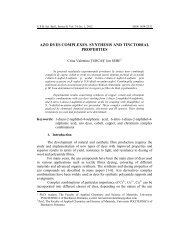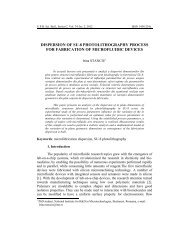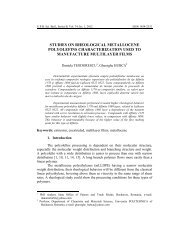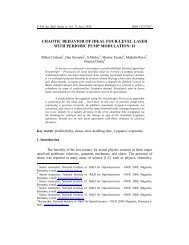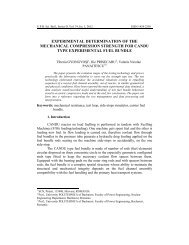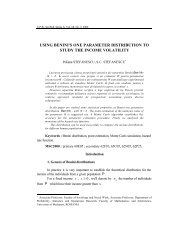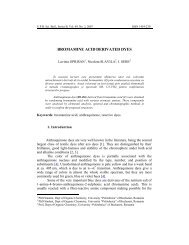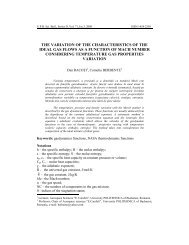T - Scientific Bulletin
T - Scientific Bulletin
T - Scientific Bulletin
Create successful ePaper yourself
Turn your PDF publications into a flip-book with our unique Google optimized e-Paper software.
U.P.B. Sci. Bull., Series D, Vol. 68, No. 1, 2006<br />
THE REDUCTION OF NITROGEN MONOXIDE<br />
CONCENTRATION TO THE COALS HAVING A HIGH<br />
CONTENT OF ASH<br />
I. PÎŞĂ, C. NEAGA ∗<br />
În lucrare autorii şi-au propus studierea formării de NO X la cărbunii cu<br />
conţinut ridicat de cenuşă. În primul rând s-a determinat timpul de uscare funcţie de<br />
masa minerală externă şi de diametrul iniţial al particulei de cărbune. În al doilea<br />
rând a fost cuantificată influenţa masei minerale asupra concentraţiei de oxizi de<br />
azot.<br />
In this paper, the authors analyse the generation of NOx in the coals having<br />
a high content of ash. On the one hand, the drying time has been determined,<br />
depending of the external mineral mass and the initial diameter of the coal particle.<br />
On the other hand, the influence of the mineral mass over the concentration of<br />
nitrogen oxides has been quantified.<br />
Keywords: steam generators, combustion, nitrogen oxides, ballast.<br />
Introduction<br />
The authors study the burning of the coals having a high content of ash which<br />
derives from the mineral mass. The mineral mass of the coal consists of:<br />
• the internal mineral mass which derives from the mineral mass of the genetic<br />
material (the combustion of the particles leads to the appearance of the<br />
internal ash which is carried from the particles surface and included in the<br />
corresponding gas phase.)<br />
• the external mineral mass which derives from the sterile drawn in the coal<br />
extraction (after the combustion it transforms into the external ash and it<br />
represents about 90% from the total mineral mass.)<br />
The methods of approaching the elementary analysis of a test carried from the<br />
raw coal bunker do not make evident the existence of such fully inert particles.<br />
The mineral mass of the initial particle having the diameter δ oc is composed of the<br />
internal mineral mass and of the external mineral mass. The extraction technology<br />
of lignite (by uncovering) leads to the idea that the external mineral mass consists<br />
of separate mineral particles (after grinding). These accompany the rest of the<br />
particle which is burning and which contains only the internal mineral mass. This<br />
∗<br />
Reader; Prof., Dept. of Classical and Nuclear Thermal Power Equipment, University<br />
POLITEHNICA of Bucharest, Romania
54<br />
I. Pîşă, C. Neaga<br />
is uniformly distributed and after burning it passed into the combustion gases. If<br />
the fraction corresponding to the external mineral mass is noted by x e (usually<br />
x e ≈ 0.90 [1]) and those mentioned above are taken into consideration, one can<br />
reach the conclusion that after the external mineral mass (the ash) is removed, the<br />
coal is enriched and will have the following elementary analysis:<br />
i 0<br />
i<br />
0<br />
i 0<br />
i<br />
0<br />
i<br />
0<br />
C = f 0 −iC<br />
,%; H = f 0 −i<br />
H , %; Sc<br />
= f0−iSc<br />
, %; N = f 0 −i<br />
N , %; O = f 0 −iO<br />
, %;<br />
i<br />
A = f0− i ( 1 − xe<br />
) A<br />
0<br />
i<br />
0<br />
, %; Wt<br />
= f0−iWt<br />
, %, (1)<br />
where the transformation factor f 0-I is given by the expression:<br />
100<br />
f0− i =<br />
(2)<br />
0<br />
100 − xe<br />
⋅ A<br />
Taking into account the transformation factor, the values of the imbibition<br />
and hygroscopic moistures (together form the total humidity) modify, as follows:<br />
i<br />
0<br />
i<br />
0<br />
Wi<br />
= f0−iWi<br />
, %; Wh<br />
= f0−iWh<br />
, % (3)<br />
The technical (immediate) analysis of the coal (the content of volatile and<br />
of fix coal) is also influenced by the transformation factor f 0-i :<br />
i 0<br />
0<br />
V = f 0 V , %; C = f C , %; (4)<br />
−i<br />
i<br />
f<br />
0−i<br />
f<br />
The removed mineral mass, after the combustion of the remaining<br />
combustible, leads to the formation of n a particles of ash. The jet of dust<br />
introduced into the furnace consists of plenty of such independent “units” (Fig. 1).<br />
A “unit” is formed by a particle which burns accompanied by the “cloud” of ash<br />
particles. If the combustion process includes the drying phase, the total burning<br />
time is divided into four areas (Fig. 2), compared with three zones [6], as follows:<br />
the drying area, the ignition area, the area of combustion of volatile substances<br />
and the zone of finishing the combustion.<br />
The drying area Z 0 corresponding to the interval 0
The reduction of nitrogen monoxide concentration to the coals having a high content of ash 55<br />
also present the burning of base of coke, a process carried on both in parallel with<br />
the combustion of the volatiles and after that. Z 1 and Z 2 zones unfold either<br />
simultaneous or they succeed one another.<br />
3<br />
Φ<br />
T g<br />
1<br />
2<br />
T fl<br />
Fig..1. Schematic representation of “one unit”.<br />
1 – coal particles; 2 – cloud of ash particles; 3 – diameter of gas cover of “one unit”, Ø<br />
The finishing zone of the combustion corresponding to the interval<br />
τ 3 < τ < τ a . This area noted Z 3 is the area when the combustion process is finished.<br />
The combustion air has been completely introduced. The particle burns fully up to<br />
the ash particle which, practically, derives from the internal mineral mass.<br />
1. The mathematical model for Z 0<br />
The equations characterizing the area Z 0 are:<br />
• for the drying dynamics:<br />
dW<br />
p<br />
dτ<br />
4<br />
[ a σ ( T − T ) + α ( T − T )]<br />
6 4<br />
kgapa<br />
= −<br />
cb o fl<br />
gc g ,<br />
rδ<br />
ρ<br />
kg ⋅ s<br />
0<br />
ap<br />
where W p is the current humidity of the coal dust, [kg humidity /kg coal ]; r – the latent<br />
vaporizing heat, r = 2258 kJ/kg; ρ ap – the apparent density, ρ ap = 900 kg/m³;<br />
δ 0 – the diameter of the burning particle, m (constant in this area); a cb – the<br />
energetic coefficient of coal emission (it can be imposed a cb = 0.8); α gc – the gas<br />
convection coefficient – particle, kW/(m²·K); the convection coefficient α gc is<br />
calculated by using the relationship [2]:<br />
2 −7<br />
5<br />
α ( 0.8805 10 0.124 10<br />
−<br />
gc<br />
= ⋅ Tg<br />
− ⋅ )<br />
(6)<br />
δ<br />
0<br />
At the initial moment,<br />
0<br />
i 0.01W<br />
h<br />
τ = 0. Wp = Wp = W<br />
0 h<br />
= , (7)<br />
0<br />
A<br />
1−<br />
xe<br />
100<br />
After τ = τ 1 (τ 1 is the drying time) W p = 0.<br />
(5)
56<br />
I. Pîşă, C. Neaga<br />
λ s<br />
r evs<br />
second. air<br />
dust, H 2O<br />
Z 0<br />
Z 1 Z 2 Z 3<br />
λ p ; r evp<br />
0<br />
τ 1 τ 2 τ 3<br />
λ second. air<br />
s<br />
r evs<br />
τ a<br />
Fig.2. The structure of the pulverized jet coal<br />
• for the variation of the temperature of the gas phase:<br />
0<br />
dTg<br />
⎧⎪<br />
⎡<br />
V dWp<br />
⎤<br />
aum<br />
= ⎨− ⎢ri ( ξ + λi − 1) + 1.242 ⋅ ⎥( Tg<br />
−273)<br />
−<br />
dτ ⎪⎩<br />
⎣<br />
τa<br />
dτ<br />
⎦<br />
''<br />
0<br />
6α<br />
gc i dWp Vaum<br />
− ( Tg −T) − ⋅ ++ ri ( ξ + λi −1) ⋅( Tfl<br />
δρ<br />
0 apcg cg dτ τa<br />
−273)<br />
− (8)<br />
2 2<br />
naαgaδa Φ σ0a<br />
⎫<br />
g 4 4 ⎪<br />
−6 ⋅ ( T ) 6<br />
3 g<br />
− Ta + ⋅<br />
3 ( Tfl −Tg ) ⎬ / VgZ0<br />
δ0ρapcg δ0ρapcg<br />
⎪ ⎭<br />
where VgZ 0<br />
is the gas volume with reference to one kilogram of drying coal ; it is<br />
calculated with the relation :<br />
0<br />
i<br />
VgZ = λ 1.242 ( 1) ( 1)<br />
0 pVaum + Wi + ⎡<br />
⎣<br />
rf ξ + λf − + revp ξ + λev<br />
− +<br />
3<br />
τ ⎤<br />
0<br />
mN<br />
+ ri ( ξ + λi − 1)<br />
⎥Vaum + 1.242 Wp<br />
,<br />
τ<br />
a ⎦<br />
kg<br />
(9)<br />
where λ p is the excess coefficient of primary air; λ i – the coefficient of air excess<br />
in the furnace at the level of burners; λλ ev – the coefficient of air excess at the<br />
evacuation; r i ,r f – the recirculating degree from the burning inlet and from<br />
furnace end-part, respectively; W i i – the imbibition humidity (it is calculated with<br />
the relation 3); V 0 aum – the theoretical volume of wet air that is corrected with the
The reduction of nitrogen monoxide concentration to the coals having a high content of ash 57<br />
transformation factor, f 0-i ; τ 0 – the total time of combustion, initially admitted<br />
between 0.5÷1.5 seconds, lately its value being checked up; c g – the heat specific<br />
3<br />
to the burning gases (it is admitted constant, c g =, =1.35 kJ /( mN ⋅ K)<br />
); i”- the<br />
enthalpy of the saturated steam, i”=2676 kJ/kg; α ga -the convection coefficient<br />
from gases to the ash particles; α ga =2λ g /δ a , where δ a =20·10 -6 m (the diameter of the<br />
ash particle); T a – the temperature of the ash, K; a g – the energetic coefficient of<br />
the gas emission inside the cover, at the temperature T g , a g = 0.3÷0.4 [5]; T – the<br />
temperature of the particle (373 K); Ф – the diameter of the cover [3], m; this<br />
diameter is calculated by the relation:<br />
1/ 3<br />
⎛ Tg<br />
0 0 ⎟ ⎞<br />
⎜ ρ ap VgZ<br />
⋅<br />
T0<br />
⎠<br />
Φ = δ , (10)<br />
⎝<br />
where T 0 is the reference temperature, T 0 =273 K and the number of ash particles,<br />
n a is calculated by the relation:<br />
0<br />
3<br />
ρc<br />
⋅ xe<br />
⋅ A ⎛ δ 0<br />
100 ⎟ ⎞<br />
= ⋅<br />
⎜<br />
c<br />
na<br />
, (11)<br />
⋅ ρa<br />
⎝ δ a ⎠<br />
where ρ a is the ash density, ρ a = 1500 kg/m 3 .<br />
• for the variation of the temperature of the ash particles:<br />
dTa<br />
6 4 4<br />
6δ<br />
0σ<br />
0acaϕ<br />
can 4 4<br />
= [ σ 0aa<br />
( T fl − Ta<br />
) + α ga ( Tg<br />
− Ta<br />
)] +<br />
( T − T ),[<br />
K / s]<br />
d c<br />
3<br />
a (12)<br />
τ ρ δ<br />
n δ ρ c<br />
a<br />
a<br />
a<br />
c a is the specific heat of ash, kJ/(kg·K); it is admitted the constant, c a = 1<br />
kJ/(kg·K); a a – the energetic emission coefficient of ash, a a =0.7; a ca the blackness<br />
coefficient of the system particle-ash [4], a ca ≈0.7; φ can – the mutual radiation<br />
coefficient between the particle and the ash, φ can = 0.2 [5].<br />
a<br />
a<br />
a<br />
a<br />
2. The mathematical model for Z 1<br />
The equations characterizing this area are:<br />
• for the dynamics of volatiles emission:<br />
−<br />
i<br />
( V −V<br />
) ⋅ e<br />
T<br />
8900<br />
dV<br />
= 150000 ⋅<br />
dτ<br />
• for the dynamics of volatile substances combustion:<br />
4650<br />
,[kg/(kg.s)]; (13)<br />
−<br />
dW<br />
T dV<br />
g<br />
W gZ1<br />
= 690 ⋅ ( V −W<br />
) ⋅CZ<br />
⋅ e + ⋅ ,[kg/(kg⋅s)], (14)<br />
1<br />
dτ VgZ<br />
dτ<br />
1<br />
where the gases volume of this zone is given by the relation:
58<br />
I. Pîşă, C. Neaga<br />
0 i<br />
⎡<br />
τ<br />
0<br />
VgZ = λ ( ) ( ) ( ) ( )<br />
1 p<br />
⋅ Vaum + 1.242Wt + ⎢rf ξ+ λf − 1 + ri ξ+ λi − 1 + revp ξ+ λev − 1 ⎤Vaum V W vv<br />
τ<br />
⎦ + − +<br />
⎣<br />
a<br />
(15)<br />
3 3<br />
⎛ δ ⎞ ⎡<br />
0 0 i<br />
⎛ δ ⎞ ⎤<br />
3<br />
+ ⎜1 − ( V 1.242 ) 1<br />
3⎟ g<br />
−Vaum− Wt −⎢⎜ − V W<br />
3⎟<br />
− ⎥( 5.6Hv + 0.8Nv + 0.7 Ov)<br />
, [ mN<br />
/ kg]<br />
⎝ δ0 ⎠ ⎢⎣⎝ δ0<br />
⎠ ⎥⎦<br />
3<br />
where v v is the specific volume of the volatiles, v v =1.307 m N<br />
/ kg [6].<br />
For the volatiles with medium composition (H v , N v , O v – mass fractions of<br />
hydrogen, nitrogen and oxygen from volatiles), the factor 5.6H v + 0.8N v + 0.7O v<br />
= 0.86 – represents the volume growth of the combustion gases at the volatiles<br />
burning [3]. The value of derivate dVgZ 1<br />
/ dτ<br />
is given by the following relation:<br />
dV<br />
2<br />
gZ<br />
1<br />
1<br />
( ) 0 ⎛dV dW ⎞ 3δ ( 0 0<br />
i dδ<br />
= ri ζ + λi −1 ⋅ Vaum + ⎜ − ⎟⋅vv − ⋅ V 1.242<br />
3 g<br />
−Vaum − Wt<br />
) −<br />
dτ τa<br />
⎝ dτ dτ ⎠ δ<br />
0<br />
dτ<br />
,(16)<br />
2 3<br />
3<br />
⎡ 3δ dδ ⎛ δ ⎞dV dW ⎤ mN<br />
−0.86 ⎢− V + 1 ,<br />
3 ⎜ −<br />
3 ⎟ − ⎥<br />
⎢⎣<br />
δ0 d τ ⎝ δ0<br />
⎠ d τ d τ ⎥⎦<br />
kg ⋅ s<br />
and the concentration of oxygen in this zone is :<br />
⎧⎪<br />
⎛ ⎞<br />
CZ = ⎨λ 1 p<br />
+ rg λf − + revp λevp − + ri λi<br />
− −⎜ − ⎟+<br />
⎪⎩<br />
⎝ ⎠<br />
3<br />
τ δ<br />
( 1) ( 1) ( 1)<br />
1<br />
3<br />
τ<br />
a<br />
δ<br />
0<br />
⎤ M<br />
O<br />
⎫ M<br />
2v<br />
⎪ O kgO<br />
2<br />
2<br />
V W M V m<br />
⎡<br />
3<br />
⎛ δ ⎞ ⎡ ⎤<br />
+ ⎢⎜1 − ,<br />
3 ⎟ − ⎥ ⎬ ⋅ ⎢ 3 ⎥<br />
⎣⎢⎝ δ<br />
0 ⎠ ⎦⎥ O2 ⎭⎪<br />
gZ1<br />
⎣ N ⎦<br />
where the mass of oxygen for burning one kilo of ennobled coal, M O2<br />
mass of oxygen for burning the volatiles,<br />
M O 2 V<br />
transformation factor f 0-i.<br />
dT<br />
dV 3 i<br />
= { ⎡cv ( T 273)<br />
Qv {( V V) cv ( T 273)<br />
Qv<br />
dτ ⎣ − + ⎤⎦ − − ⎡<br />
dτ δ ⎣ − + ⎤⎦+<br />
i<br />
i dδ<br />
6<br />
+ C ⎡<br />
f<br />
cc ( T − 273) + Q ⎤ ( 273)}<br />
f<br />
c<br />
+ c<br />
f aA T − + ⋅<br />
⎣ ⎦ dτ ρ ⋅δ<br />
(17)<br />
and the<br />
will be corrected with the<br />
• for the variation of the temperature of the coal particle:<br />
4 4 T0<br />
44<br />
⎤<br />
⋅{ σ0ac ( Tfl − T ) + αgc ( Tg − T)<br />
+ k⋅C ⋅⎡cO ( T 273) ( 273)<br />
2 g<br />
cO<br />
T<br />
2<br />
pZ1<br />
T ⎣<br />
− − −<br />
g<br />
32<br />
⎥ −<br />
⎦<br />
i<br />
⎡c ( )<br />
4 4<br />
v<br />
V − V + ⎤<br />
⎡K<br />
⎤<br />
−σ0<br />
acaϕcan ( T −Ta<br />
)}} / ⎢<br />
⎥,<br />
i i<br />
⎢<br />
⎢<br />
c s ⎥<br />
+<br />
c<br />
C<br />
f f<br />
+ caA<br />
⎥ ⎣ ⎦<br />
⎣<br />
⎦<br />
ap<br />
(18)
The reduction of nitrogen monoxide concentration to the coals having a high content of ash 59<br />
where k is the constant of the kinetic coal combustion speed and the concentration<br />
of oxygen on the surface of coke particle which burn in Z 1 is:<br />
CZ<br />
1<br />
CpZ<br />
=<br />
, (19)<br />
1 2<br />
kδ<br />
kδ<br />
1+ −0.75<br />
D D⋅ Φ<br />
where D is the diffusion coefficient, [m 2 /s]; the diameter of the cover Ф in this<br />
area results from the relation 10, in which VgZ<br />
is replaced with V<br />
0<br />
gZ .<br />
1<br />
• for the variation of the temperature of the gas phase:<br />
2<br />
dTg<br />
⎧⎪ dVgZ<br />
1 ⎛dV dW ⎞ 6δαgc<br />
= ⎨−cg ( Tg −273) −⎜ − ⎟Qv −<br />
3 ( Tg<br />
−T)<br />
−<br />
dτ ⎪⎩<br />
dτ ⎝ dτ dτ ⎠ δ0<br />
ρap<br />
2 3 3 i<br />
6δα<br />
⎡<br />
2<br />
a ga ( δ0 − δ ) ρap<br />
A ⎤<br />
6δ<br />
T0<br />
− ⎢n 3 a<br />
+ ⎥<br />
3 ( Tg −Ta)<br />
− kC<br />
3 pZ<br />
⋅<br />
1<br />
δ0ρap ⎢ δa ρa ⎥ δ0ρap<br />
T (20)<br />
g<br />
⎣<br />
⎦<br />
0<br />
⎡<br />
44<br />
⎤<br />
Vaum<br />
⋅<br />
⎢<br />
cO ( T 273) ( 273) ( 1)( 273)<br />
2 g<br />
− − cO T − + rc<br />
2<br />
i g<br />
ξ + λi − Tfl<br />
− +<br />
⎣<br />
32<br />
⎥<br />
⎦<br />
τ<br />
a<br />
2<br />
6Φ<br />
4 4<br />
⎫⎪<br />
+ a<br />
3 gσ<br />
o ( Tf<br />
l<br />
− Tg ) ⎬ /( cgVgZ<br />
),[ K / s]<br />
1<br />
δ0<br />
ρap<br />
⎪ ⎭<br />
• for the variation of the temperature of external ash particles (around the<br />
burning particle):<br />
2<br />
dTg<br />
⎧⎪ dVgZ<br />
1 ⎛dV dW ⎞ 6δαgc<br />
= ⎨−cg ( Tg −273) −⎜ − ⎟Qv −<br />
3 ( Tg<br />
−T)<br />
−<br />
dτ ⎪⎩<br />
dτ ⎝ dτ dτ ⎠ δ0<br />
ρap<br />
3 3<br />
( − )<br />
2 i<br />
6δα<br />
⎡ δ 2<br />
0<br />
δ ρap<br />
A ⎤<br />
a ga<br />
6δ<br />
T0<br />
− ⎢n 3 a<br />
+ ⎥<br />
3 ( Tg −Ta)<br />
− kC<br />
3 pZ<br />
⋅<br />
1<br />
δ0ρap ⎢ δa ρa ⎥ δ0ρap<br />
T<br />
g<br />
⎣<br />
⎦<br />
0<br />
⎡<br />
44<br />
⎤<br />
Vaum<br />
⋅<br />
⎢<br />
cO ( T 273) ( 273) ( 1)( 273)<br />
2 g<br />
− − cO T − + rc<br />
2<br />
i g<br />
ξ + λi − Tfl<br />
− +<br />
⎣<br />
32<br />
⎥<br />
⎦<br />
τ<br />
6Φ<br />
⎫⎪<br />
T ⎬ / c V ,[ K / s]<br />
⎪ ⎭<br />
2<br />
4 4<br />
+ a<br />
3 gσ<br />
o ( Tf<br />
l<br />
−<br />
g ) ( g gZ )<br />
1<br />
δ0<br />
ρap<br />
a<br />
(21)<br />
• for the variation of the diameter of the coal particle:<br />
dδ<br />
⎡δ<br />
dV 2 T ⎛<br />
⎞⎤<br />
0<br />
⎢<br />
kC ⎜<br />
1<br />
= −<br />
⎟<br />
pZ<br />
⎥ /<br />
1<br />
dτ<br />
⎢ 3 dτ<br />
ρap<br />
T ⎜<br />
g M O vM ⎟<br />
⎣<br />
⎝<br />
− O ⎥<br />
2<br />
2v<br />
⎠⎦<br />
i i<br />
( C + V −V<br />
+ A )<br />
i<br />
f<br />
,[m/s], (22)
60<br />
I. Pîşă, C. Neaga<br />
3. The mathematical model for Z 2<br />
This area is characterized by the introduction only of the secondary air or<br />
the secondary air together with the recirculated gases from the end-part of the<br />
steam generator (r evs ). This zone corresponds to the interval τ 2 ≤ τ ≤ τ 3 . The<br />
secondary air introduction period is Δ τ ( τ<br />
Δ = τ 3 - τ 2 ).<br />
The dynamics of emission of volatiles, the dynamics of combustion of<br />
volatiles and the variation of the temperature of coal particle have the same<br />
expression as relations 13, 14, respectively 18. The values of the gas volume, of<br />
the oxygen concentration in the gas stage and of the oxygen concentration on the<br />
surface of the coke particle have the following calculation formulae:<br />
- for the volume of the gas phase in Z 2 :<br />
[ λ − λ + r ( ξ + λ −1)<br />
]<br />
0 τ −τ1<br />
V gZ = V +<br />
2 gZ1<br />
i p evs ev Vaum<br />
;<br />
Δτ<br />
(23)<br />
- for the average concentration of oxygen in the gas cover:<br />
⎪⎧<br />
τ −τ1<br />
⎫ 1<br />
CZ<br />
= ⎨C<br />
+ [ − + ( − )]<br />
2 Z V<br />
1<br />
1 gZ λ<br />
1 i λp<br />
revs<br />
λev<br />
MO2<br />
⎬<br />
⎪⎩<br />
τ 2 −τ1<br />
⎭VgZ<br />
2<br />
; (24)<br />
- for the diameter of the cover Ф (which enters into the relation of calculation<br />
C ):<br />
of pZ 2<br />
πΦ<br />
3<br />
πδ<br />
=<br />
3<br />
0<br />
ρ ap<br />
V<br />
gZ<br />
T<br />
2<br />
6 6 T<br />
Other relations characterizing this area are:<br />
• for the variation of the temperature of the gas phase:<br />
g<br />
0<br />
. (25)<br />
2<br />
dTg<br />
⎧⎪ dVgZ2<br />
⎛dV dW ⎞ 6δαgc<br />
= ⎨−cg ( Tg −273) −⎜ − ⎟Qv −<br />
3 ( Tg<br />
−T)<br />
−<br />
dτ ⎪⎩<br />
dτ ⎝ dτ dτ ⎠ δ0<br />
ρap<br />
3 3<br />
( − )<br />
2 i<br />
6δα<br />
⎡ δ 2<br />
0<br />
δ ρap<br />
A ⎤<br />
a ga<br />
6δ<br />
T0<br />
− ⎢n 3 a<br />
+ ⎥<br />
3 ( Tg −Ta)<br />
− kC<br />
3 pZ<br />
⋅<br />
2<br />
δ0ρap ⎢ δa ρa ⎥ δ0ρap<br />
T<br />
g<br />
⎣<br />
⎦<br />
0<br />
⎡<br />
44<br />
⎤<br />
Vaum<br />
⋅<br />
⎢<br />
cO ( T 273) ( 273) ( 1)( 273)<br />
2 g<br />
− − cO T − r<br />
2<br />
i<br />
ξ λi Tfl cg<br />
32<br />
⎥<br />
+ + − − +<br />
⎣<br />
⎦<br />
τ<br />
a<br />
''<br />
0 τ −τ<br />
+ ⎡<br />
1<br />
( λi − λp)<br />
caumtp<br />
+ revs ( ξ λev 1)<br />
ct ⎤<br />
⎣<br />
+ −<br />
g ev ⎦<br />
Vaum<br />
+<br />
τ −τ<br />
6Φ<br />
a σ<br />
2<br />
+<br />
g o<br />
3<br />
δ0<br />
ρap<br />
− ⎬<br />
⎪ ⎭<br />
⎫<br />
T T / c V ,[ K / s]<br />
4 4 ⎪<br />
( fl g ) ( g gZ )<br />
3<br />
2 1<br />
(26)
The reduction of nitrogen monoxide concentration to the coals having a high content of ash 61<br />
dV dV<br />
0<br />
V<br />
2 aum<br />
evs ev ⋅<br />
(27)<br />
dτ<br />
dτ<br />
Δτ<br />
• for the variation of the temperature of the external ash the relation 21;<br />
• for the variation of the diameter of the particle which burns the relation 22,<br />
with the remark that C pZ is replaced with C<br />
1<br />
pZ and in the equation of the<br />
2<br />
kinetic of nitrogen volatilization is introduced V gZ . The rest of the<br />
2<br />
equations of the mathematical model remain unchanged.<br />
gZ gZ1<br />
where = + [ r ( ξ + λ −1)<br />
]<br />
4. The mathematical model for Z 3<br />
This area is a zone where the finishing of combustion takes place At the<br />
moment of start, the entire quantity of air for combustion has been introduced and<br />
all the volatiles have been released and burnt. Under these circumstances, the<br />
relations are much simplified in this area comparison with the previous zone,<br />
because:<br />
dV<br />
= 0<br />
dτ<br />
; dW<br />
=<br />
dτ<br />
0 τ −τ<br />
; 1 = 1; V = W = V i (28)<br />
τ −τ<br />
2<br />
1<br />
The volume of the gas stage of area Z 3 , the concentration of oxygen in this zone<br />
and the concentration of oxygen on the surface of the coke particle are given by<br />
the relations:<br />
⎡<br />
τ<br />
⎤<br />
VgZ = ( 1) ( 1) ( )( 1)<br />
3 ⎢λi + rg ξ + λf − + ri ξ + λf − + revp + revs ξ + λev<br />
− ⎥⋅<br />
⎣<br />
τ<br />
a<br />
⎦<br />
⎛ δ ⎞<br />
⋅ V + 1.242W + V − W v + 1− V −V −1.242W<br />
−<br />
3<br />
t<br />
( ) ⎜ ⎟( )<br />
0 i<br />
0 0<br />
aum t v 3 g aum i<br />
⎝ δ<br />
0 ⎠<br />
⎡<br />
3<br />
⎛ δ ⎞ ⎤<br />
3<br />
0.86 ⎢⎜1 V W , [ m / ]<br />
3 ⎟ ⎥ N<br />
kg<br />
δ<br />
0<br />
; (29)<br />
− − −<br />
⎢⎣⎝<br />
⎠ ⎥⎦<br />
3<br />
⎪⎧ τ ⎛ δ ⎞<br />
CZ = ⎨λ ( 1) ( ) ( 1) ( 1)<br />
1<br />
3 i<br />
+ rf λf − + revp + revs ⋅ λev − + ri λi<br />
− −⎜ −<br />
3 ⎟+<br />
⎪⎩<br />
τ<br />
a ⎝ δ<br />
0 ⎠<br />
; (30)<br />
⎡<br />
3<br />
⎛δ<br />
⎞ ⎤⎫⎪<br />
M<br />
O ⎡kgO<br />
⎤<br />
2<br />
2<br />
+ ⎢1 −⎜ V W ,<br />
3 ⎟ − ⎥⎬ ⋅ ⎢ 3 ⎥<br />
⎢⎣<br />
⎝δ<br />
0 ⎠ ⎥⎦⎭<br />
⎪ VgZ<br />
m<br />
3 ⎣ N ⎦
62<br />
I. Pîşă, C. Neaga<br />
C<br />
C<br />
Z3<br />
pZ<br />
=<br />
3 2<br />
kδ<br />
k⋅δ<br />
1+ −0.75<br />
D D⋅ Φ<br />
, (31)<br />
where the diameter of the gas cover in this area is calculated by the expression:<br />
Φ =<br />
T<br />
g<br />
δ 0<br />
3 ρapVgZ<br />
⋅<br />
(32)<br />
3<br />
T 0<br />
In these circumstances the equations of the mathematical model are:<br />
• for the variation of the temperature of the gas phase:<br />
2 2<br />
dTg ⎧⎪<br />
dVgZ<br />
6δα<br />
3<br />
gc<br />
6δα<br />
a ga<br />
= ⎨−cg ( Tg −273) −<br />
3 ( Tg<br />
−T)<br />
− ⋅<br />
3<br />
dτ ⎪⎩<br />
dτ δ0ρap<br />
δ0ρap<br />
3 3 i<br />
⎡<br />
2<br />
( δ0 − δ ) ρap<br />
A ⎤<br />
6δ<br />
T0<br />
⋅ ⎢na + ⎥<br />
3 ( Tg −Ta)<br />
− kC<br />
3 pZ<br />
⋅<br />
3<br />
⎢ δaρa ⎥ δ0<br />
ρap<br />
T<br />
g<br />
⎣<br />
⎦<br />
⎡<br />
⋅<br />
⎢<br />
c<br />
⎣<br />
+<br />
O2<br />
44<br />
⎤<br />
( T − 273) − c ( T − 273) + r ( ξ + λ −1)( T − 273)<br />
g<br />
32<br />
O2<br />
0<br />
aum<br />
2<br />
''<br />
0<br />
6Φ<br />
agσ<br />
o 4 4 ⎪⎫<br />
[ λ c t + r ( ξ + λ −1)<br />
c t ] V + ( T − T ) /( c V )<br />
s aum p<br />
evs<br />
ev<br />
g ev<br />
⎥<br />
⎦<br />
i<br />
aum<br />
i<br />
3<br />
0 ρap<br />
δ<br />
fl<br />
fl<br />
g<br />
V<br />
cg<br />
τ<br />
⎬<br />
⎪⎭<br />
a<br />
+<br />
g gZ 3<br />
[K/s ] (33)<br />
• for the variation of the temperature of the external ash, the relation 21;<br />
• for the variation of the diameter of the coal particle which burns, the<br />
relation 22 ( C pZ is replaced by C<br />
1<br />
pZ 3<br />
and in the equation of the kinetic of nitrogen<br />
volatilization is introduced V<br />
gZ<br />
).<br />
3<br />
We remark that for the values of the gas volume, for the oxygen concentration in<br />
the gas stage and for the oxygen concentration on the surface of the coke particle<br />
the relations 29, 30 and 31 are used.<br />
The mathematical model is completed by the equations of generation of<br />
NO (thermal and from combustible) as follows:<br />
• the equation of the kinetic of nitrogen volatilization:<br />
v<br />
i<br />
dN ⎛ N ⎞<br />
4500<br />
−<br />
v<br />
1500 ⎜<br />
N ⎟ ⋅ e<br />
T<br />
3<br />
= ⋅ γ − ,[kg/( m<br />
dτ<br />
⎜ 100 × V ⎟<br />
N<br />
⋅ s )] (34)<br />
⎝<br />
gz<br />
⎠<br />
• the dynamics of generation of molecular nitrogen:
The reduction of nitrogen monoxide concentration to the coals having a high content of ash 63<br />
2<br />
1000<br />
−<br />
T g<br />
c<br />
c<br />
dN ⎛ N ⎞<br />
2 13<br />
1 10 ⎜ ⎟<br />
3<br />
= ⋅<br />
⋅ e [kg/( m<br />
dτ<br />
T<br />
N<br />
⋅ s )] (35)<br />
⎝ g ⎠<br />
• the formation speed of the nitrogen monoxide from the nitrogen from<br />
combustible:<br />
1,5<br />
3750<br />
−<br />
T g<br />
c<br />
dNO<br />
⎛<br />
c C ⎞<br />
11<br />
1 10 ⋅ N ⎜ ⎟<br />
3<br />
= ⋅<br />
⋅ e , [kg/( m<br />
dτ<br />
T<br />
N<br />
⋅ s )] (36)<br />
⎝ g ⎠<br />
• the generation of the nitrogen monoxide from the combustion air<br />
(according to Zeldovici):<br />
0,5<br />
64500<br />
−<br />
Tg<br />
a<br />
dNO<br />
⎛ C ⎞<br />
−<br />
13<br />
−11<br />
a 2<br />
0,5 Tg<br />
= 3.34 ⋅10<br />
N ⎜ ⎟<br />
2<br />
⋅ e −15.58<br />
⋅10<br />
( NO ) ( C ⋅Tg<br />
) ⋅ e<br />
dτ<br />
T<br />
⎝ g ⎠<br />
KgNO a 3<br />
/( m N<br />
⋅ s )] (37)<br />
The equations system formed by the four zones has been solved (in Turbo<br />
Pascal) by the Runge – Kutta method.<br />
Results and conclusions.<br />
Based on the model from the area Z 0 there have been made calculation in<br />
order to determine the drying time, obviously dependent on the initial diameter of<br />
the coal particle and on x e . For x e =0.9 and diameters of the coal particle between<br />
40÷160μm, the drying time alternates between 0.01÷0.030 seconds, according to<br />
Fig. 3.<br />
The dependence of NO c concentration on the main parameters is expressed<br />
by a relation of the form:<br />
NO c max = F(δ 0 , x e , λ p , Δτ , r evp , r evs ) , (38)<br />
where r evp , r evs – recirculating degree of the combustion gas from the steam<br />
generator end-part which are introduced with the primary air and with the<br />
secondary air, respectively.<br />
The system was solved using an inferior fuel (lignite) having the low<br />
heating value, Q i i = 7.100 kJ/kg and the concentration of the atomic nitrogen<br />
existing in fuel, N i = 0.9 %.<br />
In the Figs 4-6 the variation of the concentration of NO x is presented,<br />
depending on the initial diameter of the coal particle, on the coefficient of<br />
excessive primary air and on the time interval in which the secondary air is<br />
introduced (following the linear law of time presented in the paper) for the two<br />
cases analyzed: for x e = 1 and x e = 0.9. The other variables interfering in the<br />
mathematical model (for example, the degree of recirculating of the combustion<br />
gases) have been kept constant for all cases taken into consideration.<br />
43000
64<br />
I. Pîşă, C. Neaga<br />
Fig.3. The variation of the drying time as function of δ 0<br />
Fig.4. The variation of the concentration of NOx as function of δ 0<br />
Fig. 5. The variation of the concentration of NOx as function of λ p
The reduction of nitrogen monoxide concentration to the coals having a high content of ash 65<br />
Fig.6. The variation of the concentration of NOx as function of ∆ τ<br />
Conclusions<br />
• In the proposed physical model the secondary air linear introduction<br />
divides the combustion time into four areas: the drying area, the ignition<br />
area, the area of combustion of volatile substance and the fourth area when<br />
the combustion process is finished;<br />
• The secondary air introduction by an infinite number of air injections<br />
(continuous access) led to nitrogen monoxide from fuel concentration<br />
decreases up to 40-50% comparing to initial variant (air divided in two<br />
parts – primary and secondary air). If one takes into account the<br />
heterogeneous reduction of NO, in presence of residual coke (due to<br />
carbon monoxide reaction on coke basis surface) it is possible to obtain a<br />
total reduction of the nitrogen monoxide concentration greater than 60% -<br />
80%;<br />
• NO value diminishes when the fuel particle initial diameter increases<br />
while primary air excess coefficient decreases. It is underlined that this<br />
dynamics has a minimum NO concentration value obtained for a λ p value<br />
which is function of initial volatiles content from coal;<br />
• The results obtained demonstrated that the influence of the mineral mass<br />
over the nitrogen monoxide means, practically, a reducing of its total<br />
concentration, by an average, of 7-15 percents.
66<br />
I. Pîşă, C. Neaga<br />
REFERENCES<br />
1. Blum,I.,Barca,Fr., Chimia şi prepararea combustibililor solizi. E.D.P.,Bucureşti – 1966,<br />
pp 340;<br />
2. Bloh, A. G., Teploobmen v topcah parovâh cotlov, - L.;Energoatomiozdat. Leningrad otd-nie<br />
1984, 240 st.;<br />
3. Neaga, C., Infuenţa masei minerale interne asupra dinamicii arderii particulei de cocs.<br />
Energetica, 2/1996, pp. 52-59;<br />
4. Isachenko, V.P. and a., Heat Transfer ( Translated from the Russian ). Izd, Mir, 1977, 494 st.;<br />
5. Adzerikho, K. S. and a., Luminescence of two-phase inhomogeneous of cylindrical geometry.<br />
Int. J. Heat Mass Transfer, 1979, vol. 22, Nr.1, st. 131-136;<br />
6. Neaga, C., Pîşă, I., The influence of the recirculation of combustion gas over the dynamics of<br />
generation of nitrogen monoxide at the lignite burning with linear introduction of<br />
secondary air. The Energetic Review, no.1-2, pp. 27-35, Bucharest, ISSN 1220-5133,<br />
2002;



